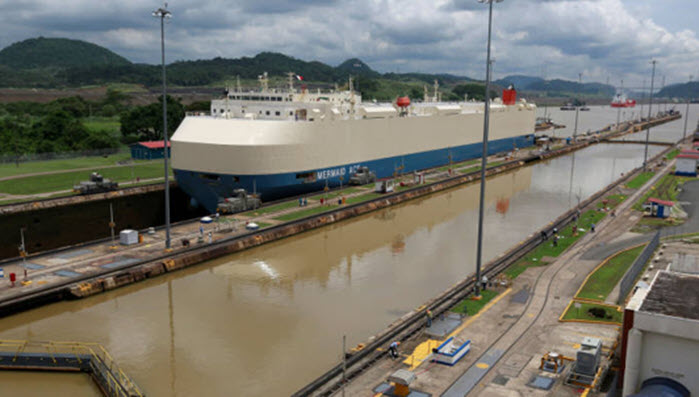
At the end of last year, the Panama Canal had a problem: too much water.
Torrential rains had swollen its main water source, the artificial Lake Gatún, beyond capacity, forcing the canal authority to open the floodgates to evacuate the excess out into the Atlantic.
But in a twist of meteorological fate, amplified by climate change, within three months the opposite was true: a severe El Niño weather phenomenon struck and the canal began imposing cargo restrictions to cope with what turned into the worst drought in its 115-year history.
“We had no rain for nearly five-and-a-half months,” Carlos Vargas, the canal authority’s executive vice-president of environment, water and energy told the Financial Times. “Usually the dry season lasts four months, but this was off the charts.”
As water levels in Lake Gatún sank as much as eight feet, five successive reductions in the weight of cargoes that ships could transport were imposed, costing the canal authority about $15m in lost fees, Mr Vargas added. About 40 ships transit the canal every day.
Panama is already suffering the impact of a changing climate, with rising sea levels threatening to submerge its idyllic San Blas island chain within decades. But the threat to a vital waterway that is synonymous with the country adds a new dimension.
“These extreme phenomena are here to stay,” said Gustavo Alanis, head of Cemda, a Latin American environmental group. “And with the risk implied by climate change, I think Panama should do more because its economy depends so much on the proper working of the canal.
”The canal, one of the world’s major trade arteries that links the Atlantic and Pacific oceans, underwent an expansion in 2016 that allowed it to accommodate bigger ships. But just three years later, additional upgrades in the form of a third lake are already needed if it is to navigate the extreme weather that is expected as a result of climate change.
Laurentino Cortizo, Panama’s incoming president who takes office in July, will have to decide whether to build a new lake in addition to lakes Gatún and Alajuela, which not only supply the canal but provide power and drinking water to more than half the country.
The canal authority will conclude a feasibility study in December for the project, which is likely to cost “hundreds of millions of dollars”, Mr Vargas said. But Félix Wing Solís, a Panamanian environmental activist, sounded the alarm and said the government must take care not to construct new lakes “at the expense of the forests — that would defeat the purpose”.
The new threat to the canal comes at a time of escalating trade tensions between the US and China and slowing world growth that have slashed the outlook for world shipping freight. Denmark’s AP Moller-Maersk, the world’s largest container shipping company, forecast growth of 1-3 per cent this year. Global shipping volumes grew 4 per cent last year.
Mr Vargas played down the impact of the shipping curbs — in the form of so-called transit drafts that limit how low vessels can sit in the water. Ships plying ports on the US east coast usually comply with the current limits anyway, he said, adding that there was no impact on some 90 per cent of the canal’s traffic.
But the commercial director of a major shipping line in Panama, who asked not to be named, disagreed. “Yes, it is having an impact on us. The same ship carries less so we either have lower turnover or higher costs,” the shipping official said.
If ships are too heavy to meet the restrictions, they have to offload containers and transit them overland, which is more expensive. “We prepare by lowering the weight so we can cross, because of the costs,” the official added.
That is a cautionary tale for Mexico, where President Andrés Manuel López Obrador hopes to revamp a train route across the Isthmus of Tehuantepec, the shortest route between the Pacific and the Gulf of Mexico, and upgrade the ports on both sides. While the government sees it as a short-cut for ships to avoid having to sail as far as Panama, shipping companies are dubious.
“It would have to be very competitive to make sense to unload, reload, unload and reload,” said the shipping official in Panama, adding that shipping companies would need vessels at each end and Mexico would need to speed up its famously bureaucratic customs formalities to make it work. Mexican freight trains have also been targeted by thieves — a further disincentive.
To great fanfare, Nicaragua announced in 2014 plans for a $50bn Chinese-built waterway to rival the Panama Canal. But the ambitious — critics said implausible — project appears quietly to have been abandoned.
Meanwhile, Panama’s prayers for rain have been answered in the past couple of weeks, enabling the authority to postpone a sixth — and it hopes final — scheduled restriction order until June 12.
“Nature has now stepped in,” said Gustavo Cárdenas, a geographer and hydrographer in Panama who studies climate change. The rainy season is expected to start in earnest by late July.